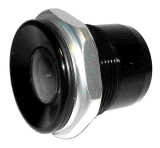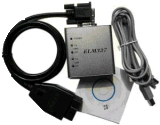Glossary of Terms
This page shows a glossary of terms used on this site. Click on the letter images shown below to jump to topics beginning with that letter.
Aspect Ratio
The aspect ratio of an image is the ratio of the width to the height. Two of the
more common ratios are 4:3 (pronounced either "four by three"
or "four to three") and 16:9.
BIOS
This stands for Basic Input Output System. It is firmware stored on a chip on the
mother board, which is the first code to be run when the computer is started. It
checks and tests parts of the system hardware and prepares the computer for loading
the main operating system software.
Codec
This is an acronym for COder DECODER. The term was
originally used when describing the operation of encoding and decoding of digital data
so it could be sent over an analogue telephone line using a modem.
A modem converted a digital signal to analogue then back to digital. A codec converts
analogue to digital then back to analogue.
A codec is a software algorithm which once installed, can be used by programmes which
create digital media and by media players. The codec
compresses signals so the file size is minimised without serious degradation of the
original signal. This reduces the amount of storage space required and also enables
streaming transmission of the files. There are codecs available for both audio and video. Click HERE for information on
Codec Packs.
CPU
Central Processing Unit. An electronic circuit that can execute computer programs.
Nowadays this is a standardised integrated circuit capable of performing a
multitude of purposes.
DIN Slot
This refers to the original German DIN standard size for car stereo head units,
which was subsequently adopted as ISO 7736. A single DIN slot measures 180 x 50mm
and a double DIN slot measures 180 x 100mm.
DRAM
Dynamic random access memory (DRAM) is a memory type where within the integrated circuit, only one capacitor and one transistor are used to store each data bit. As with all capacitors, charge leaks
and unless refreshed regularly, the charge decays and the memory state is lost. Because of this necessity to refresh the memory, it is called dynamic or volatile memory, since it loses all its
data when powered off.
No Entry in this category.
« Back to top of page
Form Factor
When applied to computer systems, this generally refers to the physical dimensions
of the mother board. Further information HERE.
Ground Loops
A ground loop in an electrical system generally occurs where there is a connection between two points in a circuit which although supposed to be of equal potential, actually have different
potentials. This can be a major nuisance in video and audio applications, causing hum and
interference. Ground loops are generally caused by poor circuit design or installation. For audio
and video applications, good earth terminations are vital to prevent localised areas of high
resistance to current flow.
HDD
Hard Disk Drive. This is a device with one or more fast rotating "platters". These
platters have a magnetic surface and have information written to and read from them
in binary codes (a series of 0's and 1's). Follow the link for further information
on hard disk drives
Head Unit
The head unit is the control centre for a car's audio system. It typically houses
the radio receiver, CD player (cassette player for older models) and amplifier with
the volume, tone and balance controls. It is normally fitted in the centre of the
dashboard.
Impedance
A measure of the apparent resistance posed by an electrical circuit to an
alternating current.
Inverter
An electronic device which outputs alternating current (AC) from a direct current (DC) input
such as a car battery. These are commonly plugged into a car's accessory socket.
No Entry in this category.
« Back to top of pageNo Entry in this category.
« Back to top of page
Lux
The lux is the unit of illuminance and luminous emittance. One LUX = 1 lumen/m2 and
is the light produced by one candle at a distance of one meter.For video cameras, a
figure often quoted is the minimum level of illuminance at which the camera will be
able to record an image with acceptable quality. Cameras with lower lux ratings
will be able to record an image in lower light levels. The table below gives some
typical LUX values.
| Illuminance | Conditions |
| 0.1 Lux | Moonlight and a cloudy sky |
| 0.25 Lux | Bright full moon |
| 10 lux | Twilight |
| 15 lux | Good main road lighting |
| 1000 Lux | An overcast day |
| 50,000 Lux | Bright summer sunlight |
« Back to top of page
Media Player
There are many media players which can be used with Windows. Window Media Player comes
along with the Windows operating system but there are many others available. Further
information HERE. The correct
Codec must be installed for the type of file you want to play.
Modem
The term Modem is an acronym for MODULATOR DEMODULATOR.
A modem converts digital signals to analogue audio tones so that data can be transmitted
over analogue telephone lines. Another modem is required at the receiving end to convert
the audio tones back to digital signals.
No Entry in this category.
« Back to top of pageNo Entry in this category.
« Back to top of page
Pixel
Pixel is short for Picture (PIX) Element (EL). A digital image is built up of
thousands of pixels, a pixel being the smallest element of a digital image.
Athough the term pixel does not always refer to a small square or rectangle,
this is by far the most common shape it is used to describe. A screen with an
aspect ratio of 4:3 and resolution of 640x480, would
have 307,200 pixels, or just over 0.3 Megapixels.
Processor
Central Processing Unit. (see CPU.)
No Entry in this category.
« Back to top of pageNo Entry in this category.
« Back to top of page
SSD
Solid State Drive. Follow the link for further information on
solid state drives
Touch Screen
A display screen that allows the user to interact with the current application
without using the keyboard or mouse, solely by touching the screen with a finger or
stylus.
Trilateration
The determination of a position at the intersection of the distance from 3 points.
This is the principle used by satellite navigation. Follow the link for further
information on Trilateration
No Entry in this category.
« Back to top of pageNo Entry in this category.
« Back to top of pageNo Entry in this category.
laquo; Back to top of pageNo Entry in this category.
« Back to top of pageNo Entry in this category.
« Back to top of pageNo Entry in this category.
« Back to top of page« Return HOME from Glossary of Terms
my-car-computer.com








